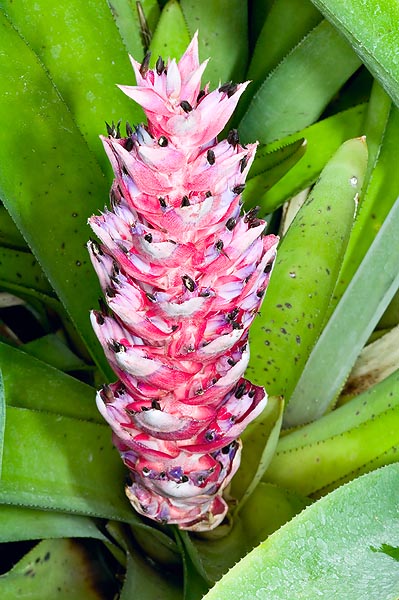Family : Bromeliaceae

Text © Pietro Puccio

English translation by Mario Beltramini

Uncommon plant, in spite of its showy inflorescence © Mazza
The name of the genus comes from the Greek “aichme” = spearhead, with reference to the thorny apices of the sepals and of the floral bracts; the species was honoured to the Prince Von Fürstenberg from whose greenhouse was coming the plant described at the origin.
Evergreen herbaceous plant, monocarpic (bearing fruit only one time during its existence), acaulescent, epiphytic, it has a funnel-shaped rosette of several leaves placed to form a central cavity usually full of water.
The leaves are pointed, bent, 50-80 cm and 3-4 cm broad, with a robust thorn at the apex and margins thickly thorny, pale green on the upper side, green grey in the lower one.
The inflorescence, at the centre of the rosette, is formed by a short floral scape ending with an erect, conical, thick, inflorescence, formed by a compound raceme, that is formed by more racemes departing from a central axis, long about 30 cm with a diameter of 10 cm, formed by ovate floral bracts with a sharp apex of red colour from which project 3 cm long, whitish, flowers. The fruit is a berry containing several fusiform seeds, long 3-4 mm.
It reproduces, besides by seed, by vegetative way, through the new plants which come out at the base of the plant and which can be detached when they have reached the size of one third of the mother plant.
Not much diffused plant, in spite of the showy inflorescence, it is cultivable in open air in the tropical and humid subtropical climates as epiphytic on the trees, for forming edges and flowers beds, on very aerated, porous, draining and very rich of organic substance substrata, in full sun or slight shade.
Its cultivation can be tried also in the warm temperate climates, in sheltered position, as it can stand, for short time, temperatures around -3 °C. It is suitable for cultivation in pot for the decoration of luminous spaces, on substrata having the same characteristics foreseen for the cultivation in open air, with temperatures over the 14-16 °C, better 20-24 °C. The substratum must be kept constantly humid in summer, slightly in winter, allowing the substratum to dry up between the watering, and the local humidity, in presence of dry air and high temperatures, can be increased with nebulisations, utilizing water at room temperature and not calcareous in order to avoid un-aestethic dots on the leaves.
In summer, some water can be left in the central cavity formed by the rosette of leaves, renewing it frequently in order to avoid it becomes a nest of mosquito larvae, whilst in winter it is better to leave it dry for avoiding possible rottenness.
Synonyms: Streptocalyx fuerstenbergii (E.Morren & Wittm.) E.Morren (1883).
→ For general notions about BROMELIACEAE please click here.
